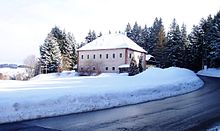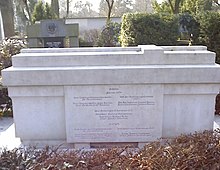Richard Hölzel
Richard Hölzel (born September 27, 1883 in Neuberg , Asch / Bohemia district ; † July 27, 1934 in Kollerschlag / Upper Austria) was an Austrian police inspector and a victim of National Socialism .
Life
Richard Hölzel (father: Johann Hölzel, dyer; mother: Margarete, née Wand), Evangelical Augsburg Confession , was married to Luzia Donabauer (born November 30, 1896 in Peilstein im Mühlviertel , † July 31, 1948 in Linz , the couple had no children). Hölzel worked from 1918 to 1920 as a gendarme in Peilstein, then in Wimsbach . Due to National Socialist activities, a gendarmerie exposition was set up in Kollerschlag in September 1933 to enable stricter border surveillance. The command was transferred to Hölzel on an interim basis. However, on July 27, 1934, Hölzel was to be transferred back to his former office in Wimsbach and by June 26, 1934, the Rayon inspector Franz Wagner from Pichl near Wels had taken over the branch command. During the night, Hölzel was murdered by invading National Socialists. On July 30, 1934, Hölzel was buried in the local cemetery in Peilstein with great public sympathy.
The attack by the National Socialists on Kollerschlag
On the night of July 26th to 27th, 1934, a unit of the Austrian Legion , coming from Wegscheid in Bavaria, attacked the post office of the gendarmerie in Kollerschlag. Revierinspektor Hölzel, who was in charge of this branch on an interim basis, was supposed to be transferred to the Wimsbach post on July 27th, which is why he celebrated his farewell to Kollerschlag the evening before with the village honors. After midnight, a shooting began between the members of the Austrian Legion who had penetrated into Kollerschlag and the sparse crew of the gendarmerie post (two gendarmerie officers and a protective corps man). Revierinspektor Hölzel, who wanted to come to the officers' help, hurried to his apartment and got his rifle. On the way back he was approached by a civilian with the words, "Inspector, we are friends". The man tried to hug Hölzel, stabbing him in the stomach and another in the hand. Hölzel collapsed, but was able to fire a few more shots from his rifle; then he was fatally wounded by several rifle bullets.
Revierinspektor Hölzel's murderer was never officially caught. There is a letter from the legionnaire Peter Mohr to his mother, in which he describes the attack on Kollerschlag and describes himself as the murderer of the district inspector Hölzel. This self-accusation was classified by the gendarmerie as "undoubted boasting". Even today there are rumors in the village about the suspected perpetrator. Of the 17 named participants in the attack, according to the files, Hans Hartmann, son of the medical officer Eduard Hartmann (1875–1937) von Wegscheid, is the most heavily incriminated should have received; Incidentally, Hartmann died in the war. Johann Geister is held responsible for the shots at Hölzel. Legal proceedings could not be opened because the suspects evaded justice by fleeing and presented themselves as completely innocent in their written statements; so the murder of the officer has never been brought to justice.
background
On July 25, 1934, the so-called July coup of the National Socialists began in Vienna with the murder of the Austrian Chancellor Engelbert Dollfuss . The putsch was ultimately unsuccessful because Federal President Wilhelm Miklas very quickly tasked Interior Minister Kurt Schuschnigg with the interim leadership of the government and the Federal Chancellery was sealed off by the armed forces, police and protective corps, so that the putschists had to surrender on the evening of the same day. However, the putschists succeeded in taking a radio building in downtown Vienna and forcing the broadcaster to make the following announcement at 13:02: “The Dollfuss government has resigned. Dr. Rintelen has taken over the business of government. ”This should be the password for alerting the SA and the beginning of the uprising of the National Socialists throughout Austria. The general director of the radio was able to call the police and after a bitter exchange of fire, the National Socialists had to surrender on the radio station at 3 p.m. So even though the coup was a failure from the Nazi perspective, local uprisings broke out in some parts of Austria.
A 30 to 40 man strong group of the Austrian Legion coming from Wegscheid under the leadership of SA-Standartenführer Hans Geister, a former and refugee pioneer captain from Linz and leader of the SA-Brigade Upper Austria in Regensburg, undertakes an attack on the border customs offices in Hanging , Kriegwald and Haselbach and also penetrates to Kollerschlag. They wanted to "fight free" the border for 500 men of the Austrian Legion, which was advancing from Bavaria. In the war forest customs house, an off duty member of the protective corps, Johann Paschinger, was seriously injured by the attackers and deported to Breitenberg (Lower Bavaria) , where he died of his severe wounds. After it became known in Germany that the coup in Vienna had failed, the 90 trucks with the Austrian Legion approaching from Regensburg were stopped near Straubing and the planned invasion did not take place. Robert Haider, the father of the Austrian politician Jörg Haider , was also present in this attack . Robert Haider was caught as a member of the SA in Nazi smear campaigns in 1933, but was able to leave for Germany and joined the Austrian Legion there. Anton Burger , who later became the commander of the Theresienstadt ghetto , and Alois Treml, who later became the National Socialist district leader of Rohrbach, were also involved in the attack .
After the attack on the Hanging border customs office, 30 legionaries drove on to Kollerschlag and carried out a fire attack on the commando. Although the post command was only weakly manned by two gendarmerie officers (Revierinspektor Anton Wagner and Gendarme Johann Zarhuber) and one protection corps man (Johann Steidl), the attackers did not succeed in taking it. After unsuccessful attacks, the putschists had to withdraw; two putschists were killed and at least five others wounded in the fighting. A legionnaire had already been killed in the attack on Haselbach. Gendarmerie Revierinspektor Hölzel also died in the attack. The legionaries then withdrew to Germany and were briefly brought into fortress custody in Landsberg am Lech , which was considered "honorary custody" because, as is well known, Adolf Hitler was also imprisoned there after the failed coup in Munich. In the Nazi press, attempts were made to downplay the events as purely internal Austrian affairs; For example, the Völkischer Beobachter wrote on July 28, 1934 under the heading "Austrian refugees arrested at the German border":
“In the Kollerschlag area, Austrian refugees tried to reach the German border. A shootout developed with heavily armed home fighters . 8 refugees reached the German border, some of them wounded, but overpowered 3 Austrian customs officers who stood in their way and made them across the border. "
In Upper Austria, further and equally unsuccessful coup attempts were made in Wilhering (see Josef Beyerl ) and Laakirchen (see Josef Maria Lukesch ), in which the National Socialists also murdered gendarmerie officers.
After the annexation of Austria on 12 March 1938 gendarmerie officials Schutzkorps- and army members were involved in the suppression of the July coup, persecuted by the Nazis and ended up in some cases in concentration camps (see. This the case of the captain Rosenkranz , who as a company commander put down the Nazi uprising in Lamprechtshausen and died in Sachsenhausen concentration camp ).
Honors
On October 28, 1934, a memorial plaque was unveiled in memory of the district inspector Hölzel who was murdered in Kollerschlag in the presence of Governor Heinrich Gleißner and an impressive public. The inscription read: “In memory of Mr. Gendarmerie Inspector Richard Hölzel, who fell as a victim of the most faithful fulfillment of duty for the people and fatherland on July 27, 1934.” This memorial plaque was removed during the Nazi era July 1938, a memorial plaque for the SA men Fritz Obermüller, Franz Brunnbauer and Engelbert Regner who were killed in the attempted coup was placed at the Brunnbauer Inn in Kollerschlag. In 1945 this memorial plaque was removed. On July 12, 1954, the Gendarmerie Memorial Day, the memorial plaque for Richard Hölzel, which is now on the building of the Kollerschlag community, was erected again.
In addition, a memorial was erected at the Barbarafriedhof in Linz on May 23, 1935 for the members of the armed forces, gendarmerie officers and Schutzkorpsmen who fell in February 1934 (uprising of the Social Democrats, the so-called February uprising ) and July 1934 (July coup of the National Socialists), along with gendarmerie district inspector Richard Hölzel was thought. The monument was renovated in 2010.
Individual evidence
- ↑ Heimatbuch Peilstein, pp. 10 and 11.
- ↑ Saxinger, Franz (editors). Kollerschlag 1934. Self-published: Published by the municipality of Kollerschlag.
- ↑ Kurt Bauer: The attack of the Austrian Legion on Kollerschlag ( Memento of the original from October 8, 2007 in the Internet Archive ) Info: The archive link was inserted automatically and not yet checked. Please check the original and archive link according to the instructions and then remove this notice. (PDF; 191 kB); therein: Letter from a legionnaire about the murder of the gendarmerie district inspector Richard Hölzl [sic] in Kollerschlag in the upper Mühlviertel (Upper Austria) on July 27, 1934 .
- ↑ He was the most zealous Nazi doctor in Passau when it came to sterilizing so-called "hereditary diseases"; even the Passau Hereditary Court had to take corrective action against his zeal. Horst W. Heitzer, 2005, pp. 115 and 182.
- ↑ OÖLA, 2 St. 3775/34 and District Court Rohrbach Z 141/34.
- ^ Bauer, Kurt: Socio-historical aspects of the National Socialist July coup 1934. (PDF file; 2.8 MB) Dissertation, Vienna 2001. Cf. Winfried R. Garscha: July coup 1934 ( Memento of the original from March 5, 2016 in the Internet Archive ) Info : The archive link was inserted automatically and has not yet been checked. Please check the original and archive link according to the instructions and then remove this notice. . In: doew.at.
- ↑ Christa Zöchling: Wehrmacht Service: The Past of Jörg Haider's Father Robert. In: Profile Online, August 24, 2009. See Fritz Winkler: Grenzland. Chronicle of an eventful time. Mühlviertel - Bavaria - Bohemian Forest. District home association Rohrbach, Kollerschlag 2004.
- ^ Hauptmann Rosenkranz - Fight against National Socialism .
literature
- Horst W. Heitzer: Forced sterilization in Passau. The genetic health policy of National Socialism in Eastern Bavaria 1933–1939. Böhlau Verlag, Cologne, 2005, ISBN 3-412-23605-5 .
| personal data | |
|---|---|
| SURNAME | Hölzel, Richard |
| BRIEF DESCRIPTION | Austrian gendarme |
| DATE OF BIRTH | September 27, 1883 |
| PLACE OF BIRTH | Peilstein in the Mühlviertel |
| DATE OF DEATH | July 27, 1934 |
| Place of death | Kollerschlag |


